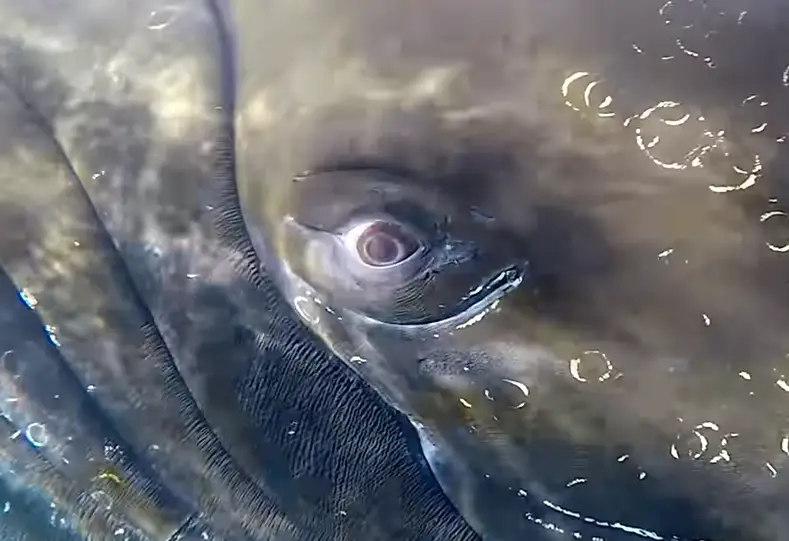You might think that, as the largest living animals, blue whales have the largest eyes. But you’re mistaken. The eye of this massive creature is comparatively the same as a cow’s eye. Yes, a blue whale’s eye is not as big as you might think.
In this article, I will explore the intricate anatomy of blue whales’ eyes and dive into their visual capabilities.
Anatomy of a Blue Whale’s Eye
The blue whale, scientifically known as Balaenoptera musculus, is the largest animal on Earth, growing around 100 feet in length and weighing around 150-180 tons. With such an immense body size comes the need for sensory adaptations to navigate the open ocean and locate food sources.

One remarkable adaptation is the blue whale’s eye, which plays a crucial role in the mammal’s navigation, foraging, and communication.
Location
The blue whale eye is situated in the lower front part of the head, providing impressive peripheral vision. The eye’s placement allows the whale to look downward when surfaces to breathe, enabling it to avoid collisions with objects such as icebergs and other marine life.
Outer Anatomy
The blue whale’s eye is enclosed in a deep, bony orbit which offers protection against physical damage. The skin that surrounds the eye is thick and highly vascularized, providing strength and resilience.
The eyelids are muscular and possess swiftly-reacting reflexes, enabling the whale to simultaneously protect and clean the eye from debris or foreign objects.
The blue whale also has specialized glands called Harderian glands that secrete an oily substance to keep the eye moist and lubricated in the salty ocean environment.
Inner Anatomy
The cornea of a blue whale’s eye is relatively flatter and more elliptical than many other marine mammals. This feature reduces the spherical aberration when the whale is submerged, thus improving underwater vision. The aqueous humor, which is the clear fluid found between the cornea and the lens, is rich in proteins, allowing for better light penetration through the eye.

Additionally, the lens of the blue whale is spherical and highly flexible, allowing for precise focusing on objects both near and far.
The blue whale’s retina is equipped with rod and cone cells, responsible for vision in dim and bright light conditions, respectively. The rod cells enable the blue whale to see in low-light environments at great depths where sunlight is scarce.
Meanwhile, cone cells are responsible for detecting colors and fine details. The blue whale has more rod cells than cone cells, ensuring optimal vision during dark ocean depths.
A unique adaptation of the blue whale’s eye is the presence of a reflective layer called the tapetum lucidum. This structure is situated behind the retina and is composed of guanine-rich crystals.
The tapetum lucidum reflects light back onto the retina, thereby enhancing the whale’s vision in low-light conditions. This enables its critical ability to forage for krill in the deep ocean depths.
How Big Is a Blue Whale’s Eye?
Regarding size, a blue whale’s eye is roughly the same magnitude as a grapefruit, corresponding to a diameter that varies between 4 and 6 inches (approximately 10 to 15 centimeters).
According to some researchers, blue whales’ eyes size can be similar to cows’ eyes. Despite being seemingly modest for such an immense creature, it is worth noting that the blue whale’s eye is still larger than most other mammals’ eyes.
When considering the weight of this marine giant’s eye measures around 750 grams, or 1.65 pounds, making it quite dense and heavy despite its deceptive size.
The blue whale’s eye is designed to endure the harsh ocean environment, high pressures, and depths. They can dive up to 1,640 feet (500 meters) and need specialized adaptations in their eyes to function effectively at those depths.
The blue whale’s sclera is particularly thick and robust, serving as an essential protective feature for these animals when they hunt or swim at such high speeds.
Furthermore, though their eyes may seem small for their size, they are efficient enough to allow them to observe their surroundings and keep themselves out of harm’s way.
How Far Can a Blue Whale See?
The eyesight of a blue whale is not as sharp as that of humans. In optimal conditions (clear water, no obstructions), a blue whale can see up to around 35 feet (10.7 meters).
These majestic giants have eyes roughly the size of a grapefruit, which enable them to perceive their surroundings and respond accordingly. However, as mentioned earlier, their visual range does not match that of humans, and their eyes are not their primary sensory organ.
Instead, blue whales rely heavily on their auditory and tactile senses to navigate and communicate in the ocean’s dark depths.
This limitation in eyesight is partly due to the nature of the underwater environment, where visibility dramatically diminishes as light is absorbed and scattered by water, suspended particles, and marine organisms.
As a result, even under perfect circumstances with clear water and no obstructions, a blue whale’s vision is restricted to a distance of around 35 feet (10.7 meters). This visual range is highly variable and could be significantly reduced in murkier or darker conditions, much like a human vision on land is heavily affected by weather, lighting, and other environmental factors.
Can Blue Whales See Color?
Blue whales are color blind, along with other whale species. They are unable to see color due to their monochromatic vision. This means that their eyes can only register different light and dark variations rather than the wide range of colors that humans and other animals can perceive.

In the deep ocean environment where blue whales reside, the ability to see a wide range of colors becomes less important, as the available colors in their natural surroundings are limited.
Color vision in animals primarily depends on the presence of photoreceptor cells called cones, which are specialized for detecting different wavelengths of light. Typically, animals such as humans possess multiple types of cone cells, each sensitive to a specific range of wavelengths (colors).
However, it has been discovered that cetaceans, including blue whales, have only a single type of cone cell. This means that their eyes can only register a single wavelength of light, rendering them incapable of perceiving different colors.
This unique feature of their vision could be an adaptation to their deep ocean habitat, where sunlight diminishes as they dive deeper, reducing the visibility of colors. Detecting only brightness and contrast may be more efficient and beneficial for blue whales in these dark waters.
In fact, blue whales rely more on their highly developed senses of hearing and echolocation to navigate, hunt, and communicate underwater.
The process of evolution has likely prioritized this acute sense of hearing and echolocation in whales over the ability to see color, as it plays a more crucial role in their day-to-day survival.
Do Blue Whales Have Eyelids?
Like other mammals, blue whales have eyelids, which protect and moisten the eye. However, their eyelids are uniquely adapted to the marine environment in which they live.
Blue whales possess a specialized, three-part eyelid system comprising an upper eyelid, a lower eyelid, and a third, nictitating membrane. This additional membrane acts like a translucent windshield wiper, offering extra protection and moisture to the eye.
The upper and lower eyelids primarily shield the whale’s eye from debris, sunlight, and potential predators. These eyelids are lined with small, specialized hairs called cilia, which serve to prevent foreign particles from entering the eye. When the whale is not actively using its vision, these eyelids remain closed to protect the eye, opening only as needed.
The nictitating membrane serves several crucial functions for the blue whale. It can be drawn across the eye to provide extra protection during high-speed swimming or diving to great depths. This semi-transparent membrane allows the whale to maintain a level of visibility while protecting its eye from harmful particles and high water pressure.
Furthermore, the nictitating membrane helps to spread tear film evenly across the surface of the eye, ensuring that it remains moist and lubricated.
In addition to their protective functions, the eyelids of blue whales play a role in the animal’s complex social behaviors. When interacting with one another, blue whales can use slight movements of their eyelids to communicate with their conspecifics, thereby conveying information about their emotional state or intentions.
Do Blue Whales Have Eyelashes?
No, blue whales don’t have eyelashes, however, they have eyelids. Their morphology is well-adapted to their marine environment, and certain characteristics are either functionally unnecessary, such as hair or eyelashes, or modified to suit their aquatic habitat.
To fully understand why blue whales do not have eyelashes, first, know the purpose of eyelashes in the animal kingdom and how that purpose is rendered unnecessary in these marine giants.
In many land-dwelling animals, eyelashes serve to protect the eyes from foreign particles such as dust and sand, as well as trap and move away moisture from entering the eye. It also has a sensory function, acting as whiskers do on mammals, letting the animal know through touch when an object is near its eye.

In the case of blue whales, their eyes are adapted for underwater vision. They possess a spherical lens that is particularly suited for focusing on objects underwater. This aqueous environment naturally keeps particles away from their eyes compared to the air on land, reducing the need for eyelashes in that protective function.
The ocean’s buoyancy and the cetaceans’ adapted skin, like eyelids, also help to minimize the debris and particles around them that could trouble their eyes.
Additionally, the blue whale’s eyes are positioned on the sides of their heads, which reduces the risk of direct contact with objects. As they do not rely solely on a vision for navigation, having an acute hearing sense, the collision risk is minimized.
Do Blue Whales Have Tear Glands?
No, blue whales don’t have tear glands. Instead, blue whales’ special nictitating membrane produces enough moisture to keep their eyes clean and healthy.
The purpose of a tear gland is mainly to produce tears to keep the eyes moist and flush out any debris that may enter the eye. In blue whales, this role is fulfilled by the nictitating membrane. The marine environment in which they also live naturally keeps particles away from their eyes, reducing the need for tear glands.
Conclusion
Now, you have a compact knowledge of blue whales’ grapefruit-sized eyes, including anatomy and other details. If you still have any doubts regarding this, just let me know.


2 thoughts on “How Big Is a Blue Whale’s Eye?”